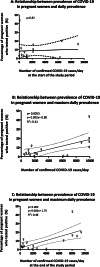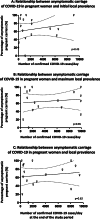Samba II PCR testing for COVID-19 in pregnant women: a retrospective cohort study and literature review
- PMID: 33731037
- PMCID: PMC7968137
- DOI: 10.1186/s12884-021-03653-4
Samba II PCR testing for COVID-19 in pregnant women: a retrospective cohort study and literature review
Abstract
Background: Asymptomatic carriage of COVID-19 in pregnant women has been reported and could lead to outbreaks in maternity units. We sought to ascertain the impact of rapid isothernal nucleic acid based testing for COVID-19 in an unselected cohort of pregnant women attending our maternity unit. We also assessed the correlation between community prevalence and asymptomatic carriage.
Methods: Data for the retrospective cohort study were collected from a large UK tertiary maternity unit over a 4-week period using computerised hospital records. Literature searches were performed across multiple repositories. COVID-19 prevalence was extracted from online repositories.
Results: Nasopharyngeal and oropharyngeal swabs were obtained from 457/465 (98%) women during the study period. The median turnaround time for results was 5.3 h (interquartile range (IQR) 2.6-8.9 h), with 92% of the results returned within 24 h. In our cohort, only one woman tested positive, giving a screen positive rate of 0.22% (1/457; 95% CI: 0.04-1.23%). One woman who tested negative developed a fever postnatally following discharge but was lost to follow-up. From our literature review, we did not find any correlation between asymptomatic carriage in pregnant women and the reported regional prevalence of COVID-19.
Conclusions: Testing using the SAMBA-II machine was acceptable to the vast majority of pregnant women requiring admission and had a low turnaround time. Asymptomatic carriage is low, but not correlated to community prevalence rates. Screening pregnant women on admission will remain an important component in order to minimise nosocomial infection.
Keywords: COVID-19; Pregnancy; SARS-CoV-2; Universal screening.
Conflict of interest statement
All authors have completed the ICMJE uniform disclosure form at
Figures



Similar articles
-
Severe acute respiratory syndrome coronavirus 2 (SARS-CoV-2) universal screening in gravids during labor and delivery.Eur J Obstet Gynecol Reprod Biol. 2021 Jan;256:400-404. doi: 10.1016/j.ejogrb.2020.11.069. Epub 2020 Dec 1. Eur J Obstet Gynecol Reprod Biol. 2021. PMID: 33285496 Free PMC article.
-
Questionnaire-based vs universal PCR testing for SARS-CoV-2 in women admitted for delivery.Birth. 2021 Mar;48(1):96-103. doi: 10.1111/birt.12520. Epub 2020 Dec 1. Birth. 2021. PMID: 33263210 Free PMC article.
-
Initial findings of universal screening for SARS-CoV-2 in women admitted for delivery in North Wales: a prospective multicentre cohort study.J Obstet Gynaecol. 2022 Jul;42(5):1122-1125. doi: 10.1080/01443615.2021.2011179. Epub 2022 Jan 7. J Obstet Gynaecol. 2022. PMID: 34996339
-
Universal screening for SARS-CoV-2 infection: a rapid review.Cochrane Database Syst Rev. 2020 Sep 15;9(9):CD013718. doi: 10.1002/14651858.CD013718. Cochrane Database Syst Rev. 2020. PMID: 33502003 Free PMC article.
-
Universal Testing Policy for COVID-19 in Pregnancy: A Systematic Review.Front Public Health. 2022 Feb 8;10:588269. doi: 10.3389/fpubh.2022.588269. eCollection 2022. Front Public Health. 2022. PMID: 35211434 Free PMC article.
Cited by
-
Prevalence of SARS-CoV-2 in Pregnant Women Assessed by RT-PCR in Franconia, Germany: First Results of the SCENARIO Study (SARS-CoV-2 prEvalence in pregNAncy and at biRth In FrancOnia).Geburtshilfe Frauenheilkd. 2022 Feb 11;82(2):226-234. doi: 10.1055/a-1727-9672. eCollection 2022 Feb. Geburtshilfe Frauenheilkd. 2022. PMID: 35169390 Free PMC article.
References
-
- WHO. Rolling updates on coronavirus disease (COVID-19). https://www.who.int/emergencies/diseases/novel-coronavirus-2019/events-a.... Accessed 1 Aug 2020.
Publication types
MeSH terms
LinkOut - more resources
Full Text Sources
Other Literature Sources
Medical
Miscellaneous

